導盲犬繁殖計劃
自協會成立至2016年,我們一直從不同的導盲犬學校引進幼犬,以擴大香港導盲犬的血統。自2017年1月起,我們開展了自己的繁殖計劃,並建立一隊義務幼犬支援小組及與其他國際導盲犬學校互相分享犬隻繁殖數據。至2019年,協會已成功在本地繁殖了10胎, 總共50隻幼犬。
我們需要種犬家庭!詳細資料,請電郵至info@guidedogs.org.hk查詢。
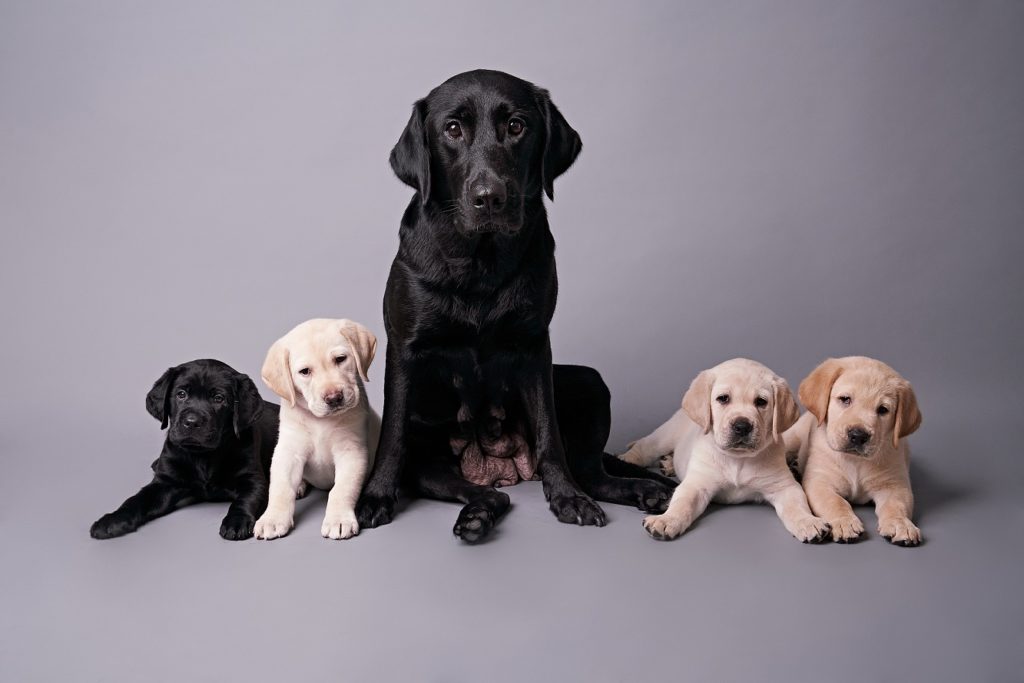
4隻導盲幼犬及種犬 (從左至右):黑色導盲幼犬、黃色導盲幼犬、黑色種犬、另外兩隻黃色導盲幼犬
4 guide dog puppies and brood bitch (from left to right): black guide dog puppy, yellow guide dog puppy, black brood bitch, two other yellow guide dog puppies
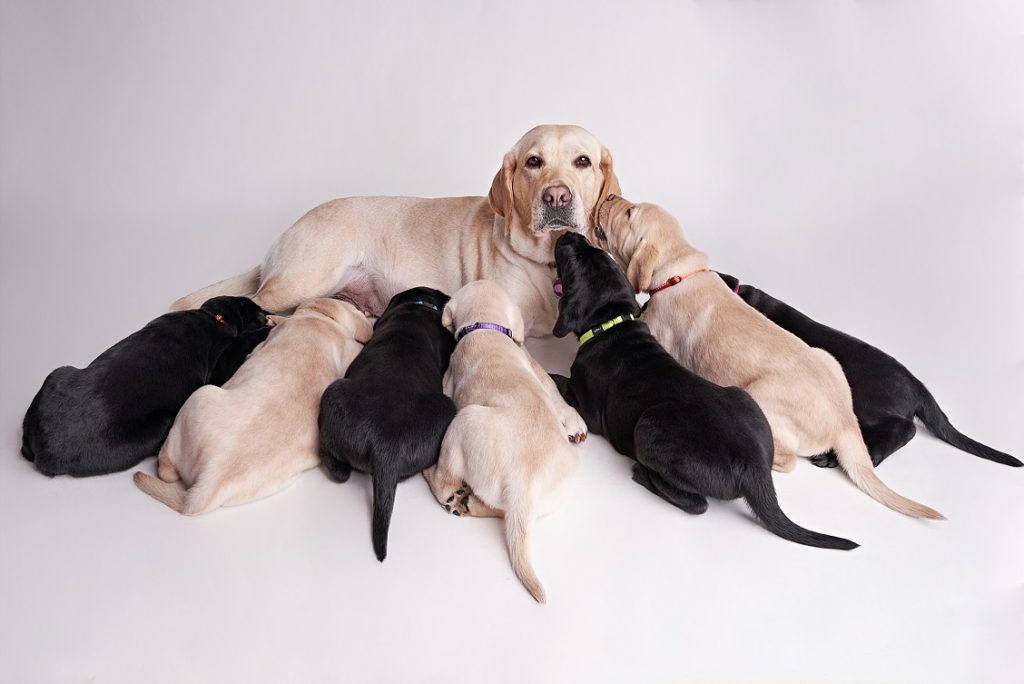
7隻導盲幼犬在前面(黑、黃、黑、黃、黑、黃、黑)及黃色種犬在後。有兩隻導盲幼犬想親種犬。
7 guide dog puppies at the front (black, yellow, black, yellow, black, yellow, black) and yellow brood bitch at the back. Two puppies tried to kiss their mom.
寄養/寄宿/暫托家庭計劃
寄養家庭及寄宿家庭在服務犬訓練中是一個不可或缺的部份。願意成為寄養及寄宿家庭,必須是一個肯承擔、願意付出時間,充滿熱誠的義工。作為服務犬訓練中的第一個階段,義工的工作、付出以及回報非筆墨所能形容。
我們的服務犬計劃分為兩個階段: 寄養家庭 及寄宿家庭。每階段有不同的需要、訓練及時間框架。暫托家庭會作備用的義工, 因此對協會亦相當重要。
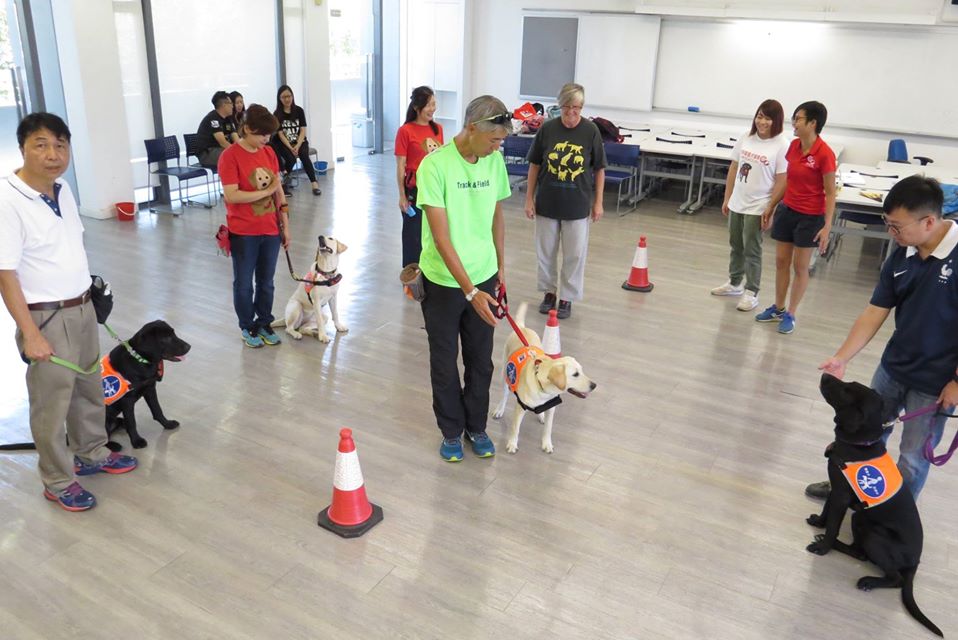
5個寄養家庭帶領5隻導盲幼犬於室內進行訓練
5 puppy raising families brought 5 guide dog puppies to train indoor
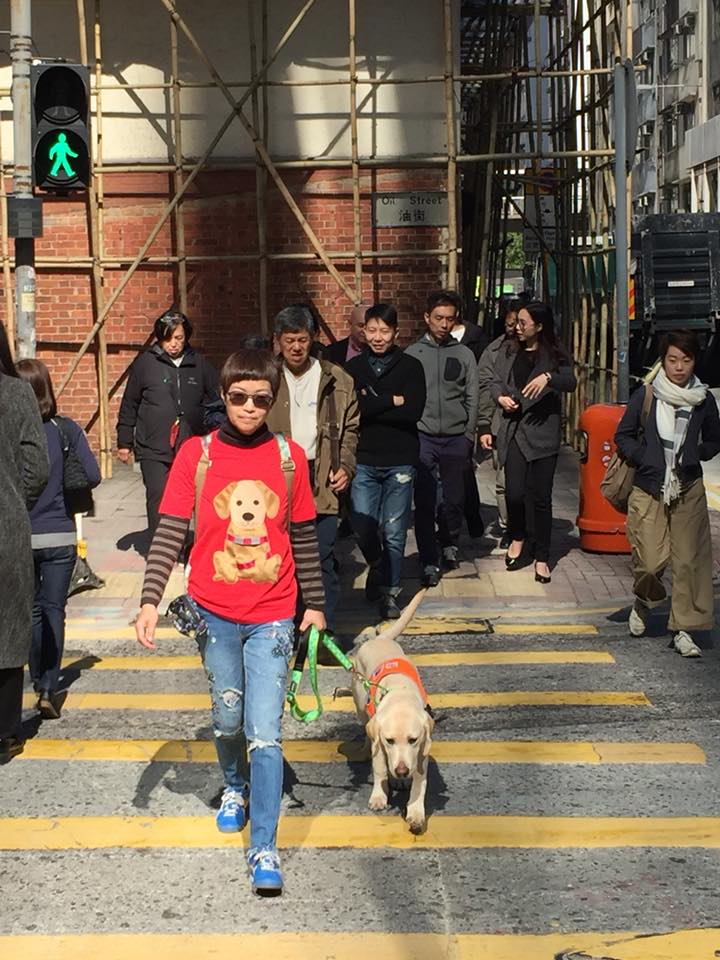
寄養家庭帶領黃色導盲幼犬過馬路
Puppy raiser brought yellow guide dog puppy to cross the zebra-crossing
以下是每個類別的說明,以幫助義工確定哪種方案最適合他們的生活方式。
寄養家庭
寄養家庭計劃包括12-16個月的時間範圍。 8週齡的幼犬將被寄養家庭帶回家為他/她提供護理,直到他們達到約14個月大。 除了基本護理,寄養家庭還將提供社會化培訓(人、其他狗/動物、環境),基本服從訓練和廁所訓練(具體時間和地點)。
按此申請及了解更多
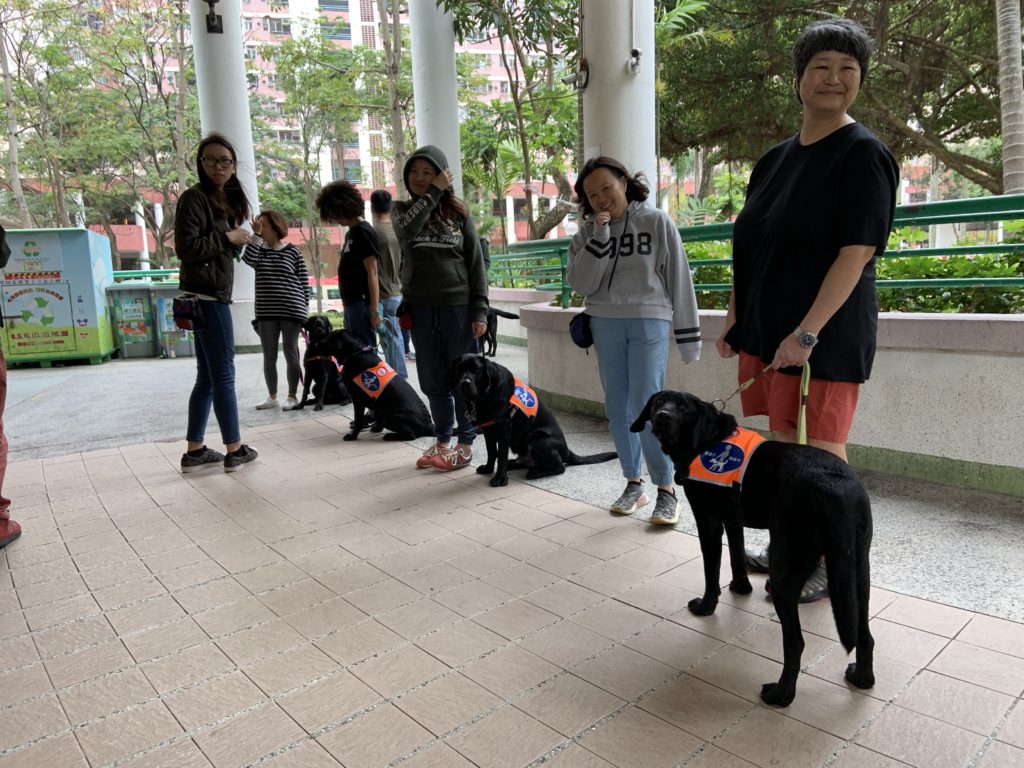
5個寄養家庭帶領5隻黑色導盲幼犬於翠屏商場入進行訓練
5 puppy raising families brought 5 black guide dog puppies to train in Tsui Ping Shopping Mall
寄宿家庭
這是我們的服務犬計劃的第二階段,因為犬隻從幼犬成長為青少年,並將開始他們的高級服務犬訓練。 在這個階段的犬隻將是14-18個月,並將與寄宿家庭同住約6-9個月。 寄宿家庭這一階段的主要目標是與服務犬一起在日常生活中進行高級訓練。
按此申請及了解更多
暫托家庭
暫托家庭將為受訓中或已服役的導盲犬及輔助治療犬提供臨時護理。 該計劃允許寄養家庭,寄宿家庭和導盲犬使用者或輔助治療犬領犬員在無法照顧他們的犬隻時休假。 逗留期限可以從1天到1個月(逐個案例)。 暫托家庭預計將為犬隻提供基本護理(餵養,上廁所)並遵循服務犬基本禮儀。
我們期待你加入我們的大家庭!
| |
寄養家庭 |
寄宿家庭 |
暫托家庭 |
繁殖犬隻持有人 |
| 犬隻年齡 |
8個星期至14 – 18個月 |
14 – 24個月 |
5個月以上 |
12個月以上 |
| 居留時間 |
12-16 個月 |
6-9 個月 |
幾天至一個月 |
工作時期 |
| 寄養犬隻計劃工作坊 |
有 |
有 |
有 |
有 |
| 家庭探訪 |
有 |
有 |
有 |
有 |
| 居住地方准許飼養犬隻 |
有 |
有 |
有 |
特別要求 |
| 如果居住地方有小朋友 |
有,5歲或以上 |
有,5歲或以上 |
有,5歲或以上 |
有,5歲或以上 |
| 如果居住地方有其他犬隻或寵物 |
我們會在家訪時進行評估 |
我們會在家訪時進行評估 |
我們會在家訪時進行評估 |
我們會在家訪時進行評估 |
| 準申請者參加事前培訓 |
6個星期6課 |
6個星期6課 |
按情況要求 |
6個星期6課 |
| 參與寄養家庭/家宿家庭訓練課程 |
每月2 –3次 |
每月1次 |
按情況要求 |
按情況要求 |
| 參與幼犬/犬隻評定 |
6次 |
N/A |
N/A |
N/A |
| 接送犬隻到學校 |
按情況要求 |
星期一至五 |
按情況要求 |
按情況要求 |
| 接送犬隻到獸醫診所 |
8次/按診期/緊急情況 |
按診期/緊急情況 |
按診期/緊急情況 |
按診期/緊急情況 |
| 寄養家庭督導員/導盲犬訓練員提供獨立培訓 |
每月 |
按情況要求 |
按情況要求 |
按情況要求 |
| 寄養家庭/寄宿家庭報告 |
每月 |
每月 |
N/A |
N/A |
| 團聚 |
兩次 |
一次 |
按情況而定 |
沒有 |
| 畢業典禮 |
有 |
有 |
有 |
有 |
導盲犬訓練
在大約14-18個月大的時候,我們幼犬的體格已經完全成熟,同時,幼犬已經達到成熟水平,這正是開始正式訓練的理想時間。
我們採用食物 、讚許作為正面鼓勵的方法去訓練狗隻。獎勵 (包括身體和語言情感的表達)能夠幫助加強幼犬的推動力和自信, 讓幼犬更樂於擔任導盲犬工作。正面鼓勵的方法能夠增加訓練成功的機率和避免幼犬犯錯的機會。但在更高級的訓練中,幼犬是容許錯誤。訓練員使用口頭提示和領子提示來獲得所需的行為反應,然後對幼犬加以獎勵。
除了學習如何在幫助使用者引路時安全避開障礙物之外,導盲犬還要學習「智慧不服從指令」。當導盲犬收到有潛在危險的指令時,導盲犬會被教導不服從該指令。(例如:遇到有車輛駛過馬路時,導盲犬不會踏前馬路)同時,導盲犬會被訓練養成「無可挑剔」的行為。(當狗隻去到一些公眾場所時,例如:酒樓、雜貨店和公共交通工具),狗隻能夠免受任何干擾(例如:貓隻)。同時,所有導盲犬都擁有樂意和熱誠工作的態度。這個是他們選擇的職業!
導盲犬要學習的技能包括:
- 引領使用者直線從A點到B點
- 遇到路面有起伏時,例如:路邊、樓梯級,停下來
- 遇到高空有障礙物時,例如:樹枝,停下來
- 避開路面障礙物
以下兩種事情,導盲犬是辦不到的:
- 確認路線到指定目的地。
- 分辨交通燈號。
與視障人士配對
當一隻導盲犬成功完成其個別訓練時,牠便會與一位導盲犬訓練計劃成功申請人士作出配對。這配對程序是要保證個別犬隻的素質,能符合每一申請人士的要求;準確的配對可確保成功的訓練,並最終成為一個既長遠又成功的導盲犬團隊。
申請者必需履行其中部分的責任,方可得到一隻導盲犬,他要完成一項維期三至四星期的全面訓練。在香港,大部分的小組訓練會在服務對象家中進行。
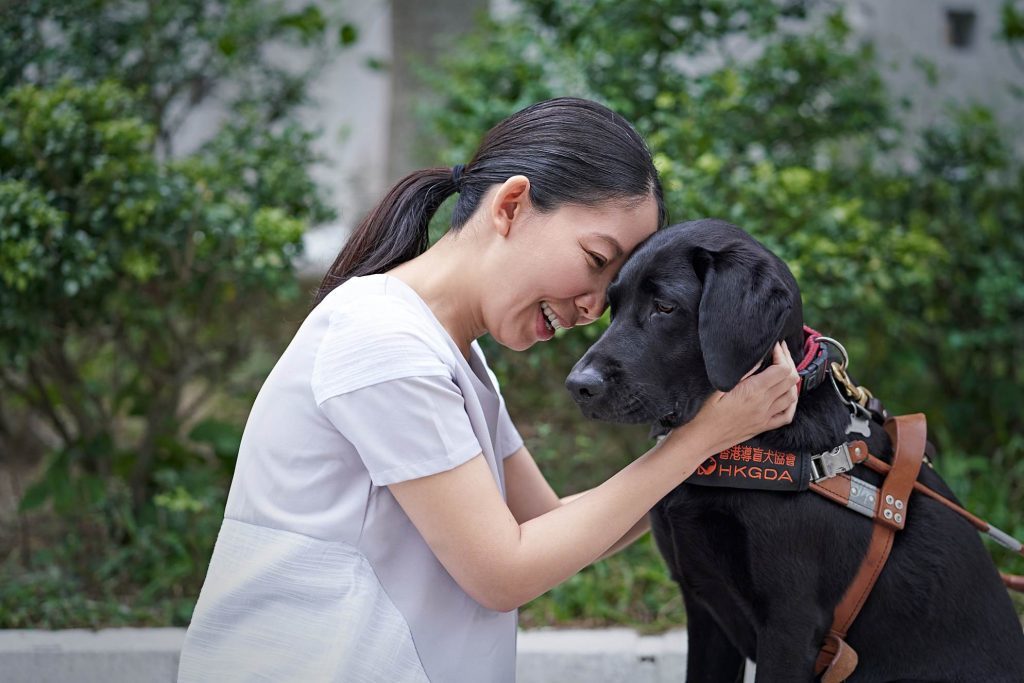
女使用者(左)頭碰著其黑色導盲犬的頭(右)。雙手撫摸導盲犬頸部。
Female user's (left) forehead touching her black guide dog (right) forehead. User patting guide dog's neck with both hands.
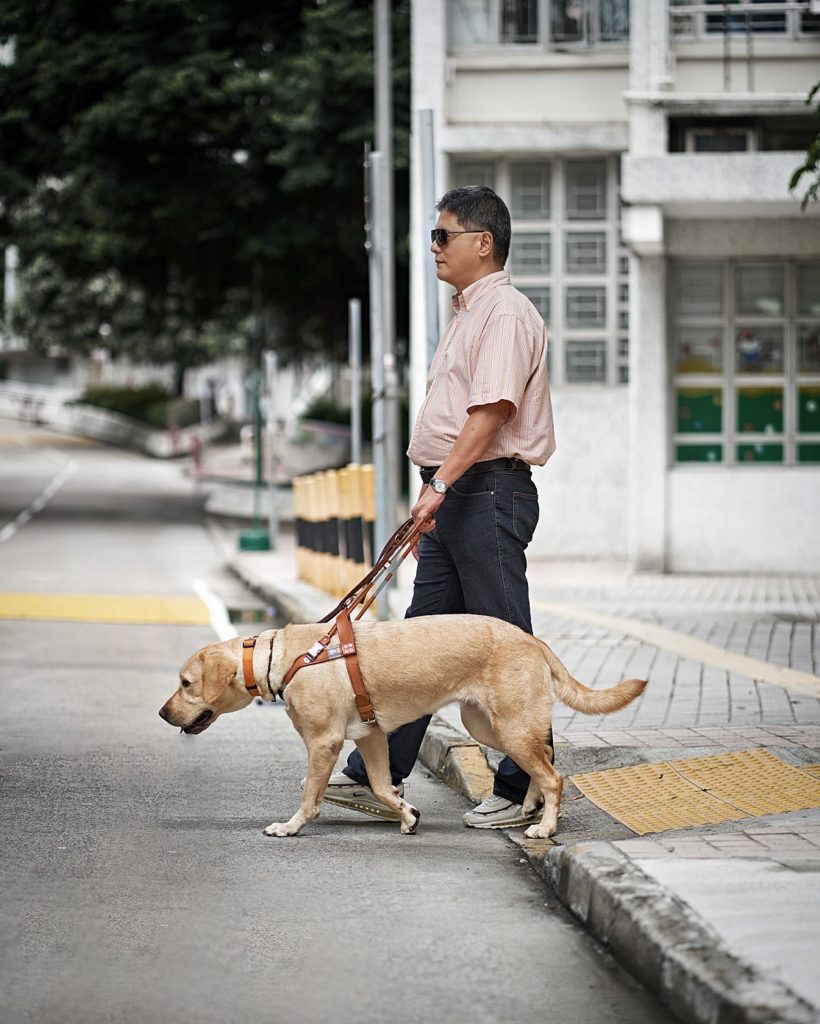
使用者及其黃色導盲犬在過馬路
User is cross the road with his yellow guide dog
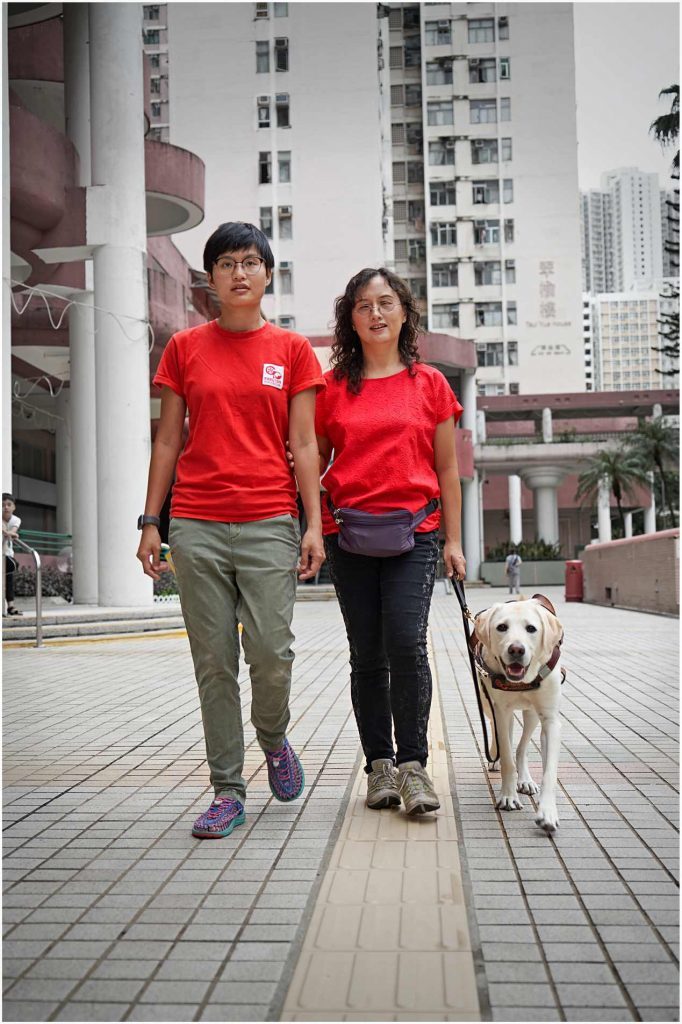
導盲犬訓練員(左)使用領路法帶領導盲犬使用者(中)及黃色導盲犬(右)向前方行走。
Guide dog trainer (left) uses sighted-guide to guide the user (middle) and the yellow guide dog (right) to walk forward.
小組訓練包括利用一連串的指令、動作及身體姿勢作出指示,練習與導盲犬溝通及互相配合。訓練時所使用的路線可以從寧靜到非常繁忙的環境,包括公共交通、電梯和自動扶梯。在一般情況下,每天完成兩條街道路線訓練,然後加上服從和社交訓練之環節。此外,在訓練期間,我們亦會教導服務對象日常如何照顧其犬隻及有關犬隻的動物福利。
我們要求服務對象參與一段時間的訓練,期間需要暫停日常工作和家務。這訓練是頗繁重,能否與其導盲犬建立良好關系,取決於他們相處時間的長短。雖然家庭成員或家中其他住客都會接觸其導盲犬,但導盲犬使用者一定要是犬隻的主要照顧者及唯一一位可以控制繫上繩束的導盲犬。
當小組訓練完成,並達到安全和合資格的標準時,導盲犬小組便可畢業了── 一件值得慶祝的事!在畢業的程序中,本會會要求服務對象簽署一份正式同意書,確保他們會遵守在小組訓練中所提供的訓練指引。
網上申請導盲犬
畢業後服務

女使用者(左)頭碰著其黑色導盲犬的頭(右)。雙手撫摸導盲犬頸部。
Female user's (left) forehead touching her black guide dog (right) forehead. User patting guide dog's neck with both hands.
香港導盲犬協會為剛畢業的導盲犬小組提供終身支援服務,此服務包括:
可透過電話或電郵聯絡香港導盲犬協會導師,查詢關於與其導盲犬配合或生活上的問題。
一個包括一年探訪畢業者一次的跟進計劃,我們會觀察其家居或工作環境,並且對小組的配合提供適切的意見。這跟進計劃之目的是確保每一導盲犬小組都能安全地運作,並達到導盲犬使用者的要求。
與導盲犬小組一起處理有關彼此配合的問題的緊急直接跟進探訪。
香港導盲犬協會為每一小組提供每年港幣$4,500資助,作為其導盲犬之獸醫護理。
導盲犬領養
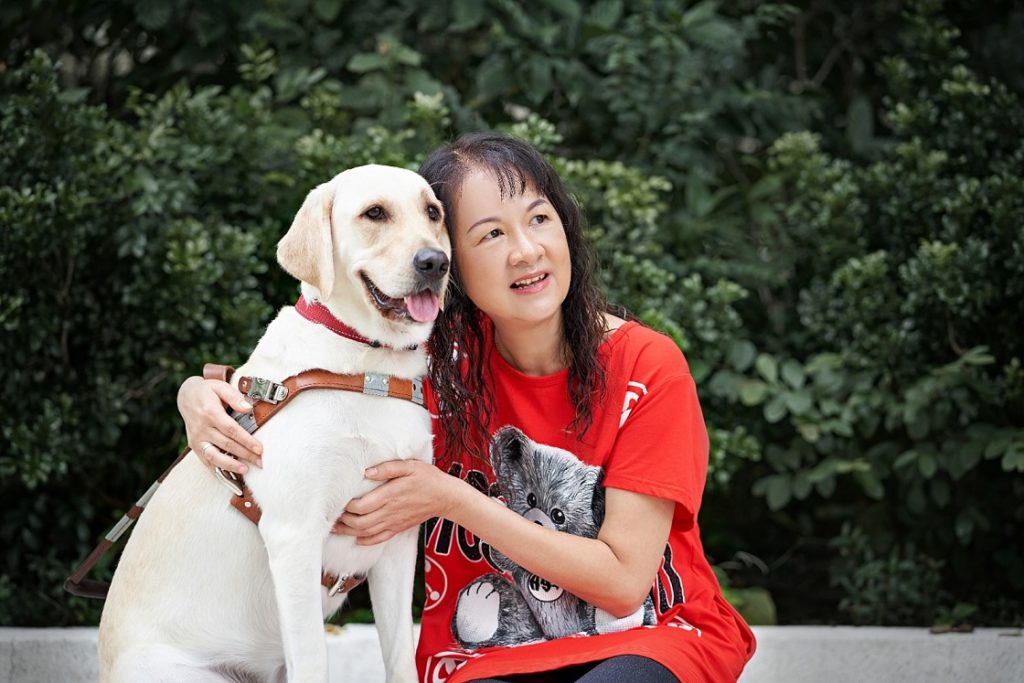
白色導盲犬與其使用者
White guide dog and its user
現在時協會有以下兩種類型的狗隻有極少數公眾領養:
- 性格喜好不合適
- 導盲犬退休
- 當狗隻不能應付導盲犬的工作時,就需要退休。雖然沒有明文規定退休年齡,但導盲犬大概到了十歲的時候,便會退休。退休的原因都跟年齡引伸的問題有關,當中包括:缺乏精力或步伐緩慢。
- 無論是什麼原因導致退休,導盲犬辛勞了一輩子,值得擁有一個長久快樂的退休生活,所以,我們會先考慮把導盲犬留在使用者身邊讓牠們度過晚年。這個對於導盲犬和使用者是最合適的安排。
- 但當使用者不能照顧退休的導盲犬時,我們會將導盲犬交給最初照顧牠們的寄養家庭。如果以上兩個方案都不行,我們會將導盲犬交給能夠給予狗隻愛與關懷的公眾人士領養。
如你希望了解更多本會的領養計劃,請電郵至 info@guidedogs.org.hk 查詢。
導盲犬講座
香港導盲犬協會於2025年11月13日推出免費校園導盲犬講座《導盲犬小Q入校園》!
講座以視障人士或訓練導師或領犬員帶同導盲犬小Q, 以分享形式讓學生認識導盲犬小Q和“三不一問”小知識 -- 不干擾、不拒絕、不餵食、主動詢問,更能瞭解小Q如何在生活上及心理上協助和陪伴視障人士。 講座時間一小時, 活動旨在培養學生同理心與愛心,營造平等包容的社會氛圍。
此專案由平等機會委員會資助,講座費用全免(名額有限,先到先得)
誠邀全港中小學或幼稚園立即報名,如有興趣請於辦公時間(9am-6pm)致電3188 1736 聯絡本協會陳先生 或電郵至 andychan@guidedogs.org.hk
#此活動內容並不代表平等機會委員會的觀點
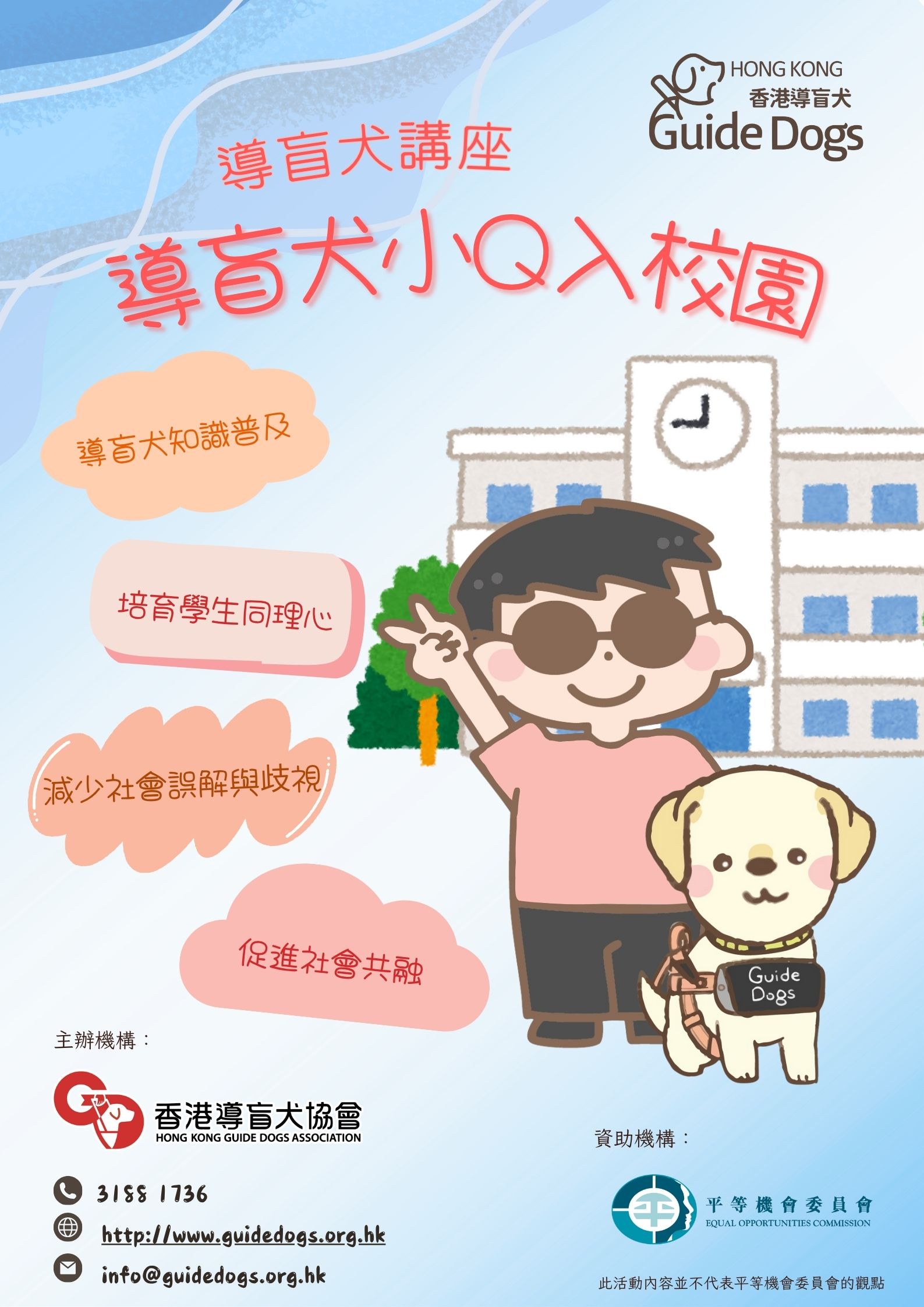
預約導盲犬公眾教育講座!
公眾教育對於導盲犬服務的發展是非常重要。 透過在學校、 機構 、社區裏,義務講解員的講解和導盲犬使用者的分享,我們不僅希望提升公眾對香港導盲犬的認識, 同時亦希望社會能夠對殘障人士更包容, 從而促進共融社會。
講座需時約60分鐘,涵蓋內容包括:
- 香港導盲犬協會的介紹
- 導盲犬的訓練階段
- 導盲犬服務的了解
- 與視障人士相處的技巧與提示
- 導盲犬使用者/ 寄養家庭分享
網上申請導盲犬講座
申請成為義務講解員
**為環保出一分力, 我們只接受網上申請。
公眾導盲犬講座
1)導盲犬講座 (1小時):
- 介紹導盲犬服務及協會工作
- 由視障人士分享經歷,導盲犬如何改變他們的生活及社交體驗
- 導盲犬工作展示
- 公眾可如何參與協會的工作,助我們達成服務使命。
參加人數:無人數上下限
舉行時間:周一至五,早上10時至下午5時
費用:港元3,000 (非牟利機構:港元2,000)
負責:講解員1位,導盲犬使用者1位,導盲犬1隻
*備註:需用英語進行講座或工作坊要另加港元1,000
2)領路法工作坊 (3小時,包括1小時講座,2小時領路法):
- 簡介香港導盲犬協會服務宗旨及工作
- 介紹導盲犬服務
- 展示導盲犬的工作
- 服務使用者分享經歷
- 展示及實踐協助視障人士定向行走的方法
- 公眾可如何參與協會的工作,助我們達成服務使命
參加人數:上限50人
舉行時間:周一至六,早上10時至下午5時
費用:港元8,000
負責:講解員1位,定向行走導師1位,導盲犬使用者1位,導盲犬1隻
*備註:需用英語進行講座或工作坊要另加港元1,000
動物(犬隻)輔助治療 (AAI)
什麼是動物(犬隻)輔助治療?
動物輔助治療是指由已受訓練的動物(犬隻)配合由專業引導員/治療師訂立具治療目標的活動,針對服務使用者的需要,作出訓練予以改善,從而令服務使用者的生活質素有所改善及提升。計劃是長期及有系統的,專業引導員/治療師會適時進行評估及調整。
動物(犬隻)輔助治療設有三項不同範疇 :
- 動物輔助治療 (AAT) : 動物輔助治療(Animal Assisted Therapy)是由註冊/認可執照的治療師,以受過訓練的動物,設計合適治療方案,讓服務使用者從中得到改善。AAT 可以配融合不同的治療手法,如職業治療、物理治療、言語治療、心理治療或行為治療等。
- 動物輔助教育 (AAE) : 動物輔助教育(Animal Assisted Education)是由註冊/認可執照的教育專業人員,運用受過訓練的動物來設計教學活動,以促進學童的學習。AAE 可以應用在常規課程,亦可應用於情緒教育、生命教育和特殊教育等課題上。
- 動物輔助活動 (AAA) : 動物輔助活動 (Animal Assisted Activity) 是讓服務對象學童與動物一起參與活動 ,以促進其身心健康 ,並透過人與動物之間的互動 , 令服務對象學童精神放鬆以及產生愉悦的情緒。
我們的工作
作為引入整全的動物(犬隻)輔助治療的機構,我們為有特殊教育需要的兒童提供犬隻輔助治療支援。專業引導員/治療師會按學生的能力差異,配合學校課程, 訂立個別學習計劃,輔助治療犬會帶動、鼓勵、協助學童完成學習計劃。
我們亦會在不同的安老院舍為老人家提供動物輔助治療。專業引導員/治療師會針對服務使用者的需要設計合適的治療性互動。希望通過輔助治療犬,讓我們的服務使用者在輕鬆和愉快的氛圍下進行互動,從以達至不同的治療目標。
"小Q伴成長"犬隻輔助介入服務計劃
香港導盲犬協會承蒙嘉道理慈善基金會資助,於2024年下旬起推行為期三年名為“小Q伴成長”犬隻輔助介入服務計劃。計劃目的主要為自閉症譜系障礙之兒童提供小組動物輔助治療/活動,藉此讓服務對象在情緒、社交、行為甚或認知能力上得到改善,以提高他們的溝通及活動能力。此外,計劃亦為服務自閉症譜系障礙兒童之專業人士及照顧者提供動物輔助介入服務講座,以提升他們對動物輔助治療之認識,並了解如何促進自閉症兒童之學習,提升其社交技巧,改善他們的情緒及減少行為問題出現。
如希望進一步了解詳情,可電郵至aai@guidedogs.org.hk或致電3188 1736 與我們聯絡。
"小Q伴成長"服務計劃申請
"小Q伴成長"服務計劃收費表
動物輔助治療申請
動物輔助治療收費表